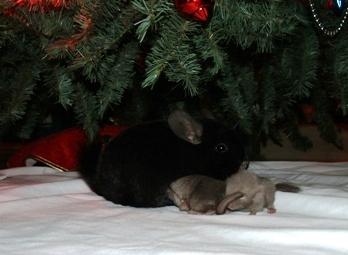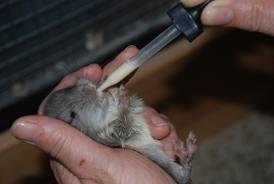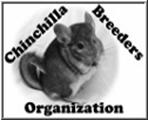Normally, the mother chinchilla takes care of all of the kits’ needs. This gives the owner time to handle and play with them. Handling kits helps to socialize the kits thus taming them. However, kits should not be taken out and carried around the house for long periods of time. Keep handling to just a few minutes at a time so that the kits can have ample time to nurse. Even with a good mother and healthy kits, there are a few things that need watching or doing.
At Birth
An additional water bottle filled with ½ unsweetened cranberry or apple juice and ½ water can help the mother with milk production by getting her to drink more. Make sure that she still has a bottle of plain water available at all times and change out the juice at least 3 or 4 times a day. The juice should only be given in the first day or two.
Once mom has finished cleaning the kits they should feel dry and their eyes should be open. Any eyes that appear stuck shut can be gently cleaned with a cotton swab and warm water. Do this until the eye opens. If the mother fails to clean a kit, gently rub the kit dry with a clean washcloth or hand towel and then give it back to the mother.
Kits should stay active. You should be able to see them nursing from time to time. One sign that they are full is that their tummies feel fully rounded and warm. The tail will also curl when the kit has a full tummy.
Weighing

A mother chinchilla with her 3 day old twins.
Weaning
Kits are normally weaned at about 8 weeks of age. Prior to this they are left with their mother round the clock. The kits may begin to eat pellets and hay while still too young to leave their mother. This is normal. Do not take them away from her until they are 8 weeks old and a minimum of 200 grams in weight as they still need nourishment from her. If they have not reached 200 grams, they will need to stay with their mother until they are big enough.
At 8 weeks, it is time to start weaning the kits that are big enough. Males and females need to be kept in separate cages. If this is not done, the males can get their mothers and even their sisters pregnant. The father can also get the female kits pregnant. None of these scenarios are acceptable.
When to Step In
Watch for any problems that may occur. If any of the following happen, PLEASE step in and help the mother.
Make sure mom is not ignoring any of the kits. If this happens, make sure the kit is warm and stays that way. If the kit is being ignored in spite of your efforts to get mom to take it, it may become necessary to hand feed the kit or find a foster mother for it.
In larger litters, kits may begin to fight with each other. In this case you will need to begin rotating the kits. To rotate kits, begin by separating them into two groups. Place one group with the mother and the others are placed in another cage or carrier. This carrier or cage should have wire spacing no larger than ½ inch by ½ inch, a small blanket or towel in the bottom and a heating pad underneath ½ of it. This will keep the kits from escaping and allow the kits to stay warmbut move to the other side of the cage if they get too hot. Make sure the heating pad is set to low. After 2 hours, swap the two sets of kits around. This should be done every two hours, around the clock. When the kits are all about the same size or get big enough, the rotation will no longer be needed. Keep in mind that it may be needed for the entire eight week period prior to weaning. Continue to weigh the kits and remember to hand feed the ones that are away from mom. Always have hay, pellets and water available to both cages. It can be surprising how young the kits will start to use them. Rotating can also be done by leaving the smallest kit(s) in with mom at all times and taking the larger ones out for two hours and then putting them back in for two hours. Hand feeding the bigger kits before putting them back in the cage can help with any fighting that may occur.
Hand Feeding

Hand feeding a young kit
Currently, there is no commercially made formula for chinchilla kits. To create your own, the most commonly used formula is as follows.
- Canned goat’s milk
- Water
- Karo syrup.
- Baby rice cereal
When feeding, do not put the formula directly into the kits mouth since they could aspirate (inhale) it and this could kill them. Instead, hold the kit upright and place a drop on its lips. The kit will lick it off. Repeat this until the kit stops eating.
This should be repeated every two hours, around the clock, if the mother has no milk or the mother dies. Depending on the kit, this will need to be done for at least 4 to 6 weeks before lengthening the time between feedings to three, and then four hours.
If the mother has milk but does not have enough, the kits can be supplemented. Supplementing involves hand feeding some or all of the kits part of the time, usually during the day and letting the mother feed them at night and when you are not feeding them. Normally, the smallest kit or two are the ones that get supplemental feedings.
Return to Top



 Site Last Updated on December 31, 1969 05:00 pm
Site Last Updated on December 31, 1969 05:00 pm